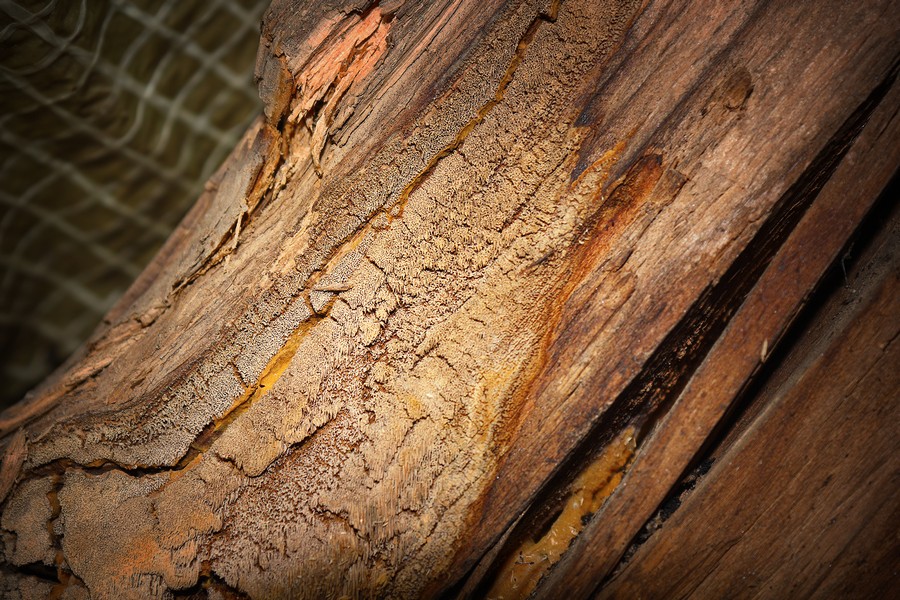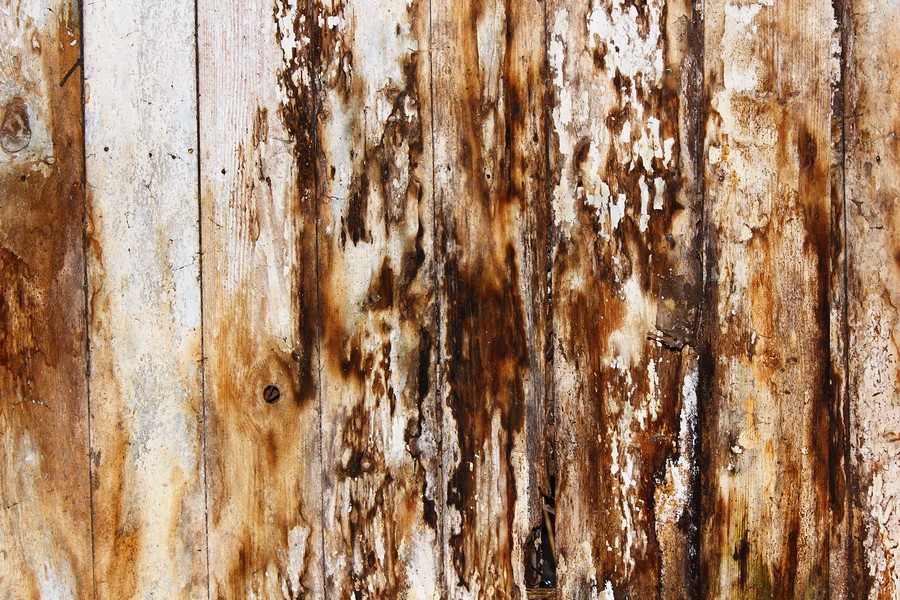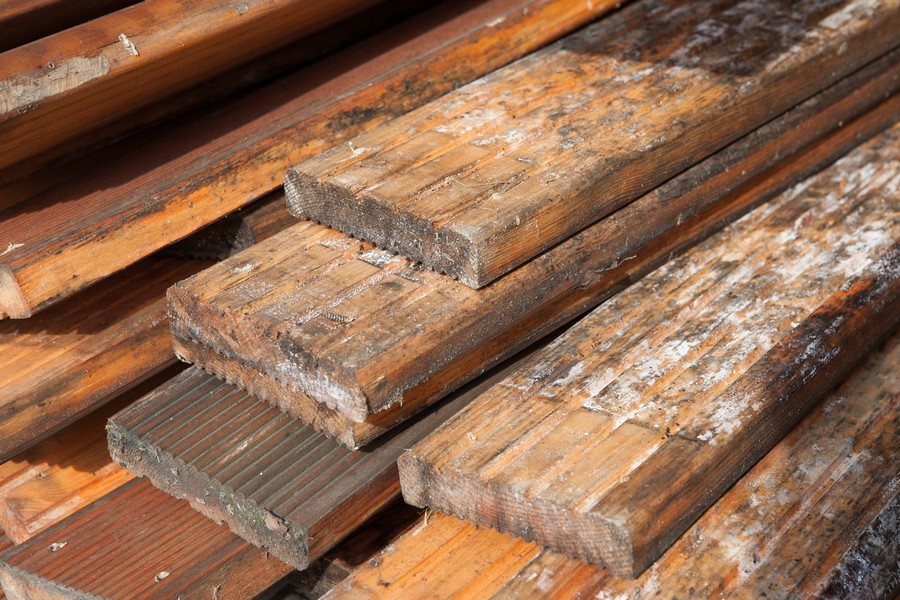Contact Sussex Damp Experts Now to Speak With an Expert.

Dry rot is a type of wood decay caused by a fungus that consumes the components of the wood that give it strength and stiffness. It was once used to characterise any fungus-caused rot of cured wood in ships and buildings, resulting in a darkly coloured, degraded, and cracked state.
Brown rot degradation induced by specific fungi that deteriorates timber in buildings and other wooden structures without an obvious source of moisture is referred to as dry rot. The name is misleading because all wood-rotting fungi require a certain quantity of moisture to start decaying. The rotted wood takes on a dark or browner crumbly appearance, with cubical like cracking or checking, and becomes brittle, crushing the wood into powder. Dry rot fungi destroy the wood in the same way as other brown rot fungus attack wood – chemically.
A dry rot outbreak in a structure can be a very dangerous infestation that is difficult to eliminate and requires urgent measures to remedy. Significant degradation can lead to structural instability and building collapse.

It usually happens where you aren’t looking. This could be hidden below the plaster, beneath the flooring, or even in the attic. This is why understanding the signs of dry rot is critical.
Dry rot can grow in any wood with high moisture content. Because dry rot can mimic other issues in its early stages, it’s crucial to get professional help. Dry rot can take hold in any building, old or new. This is due to the fact that it is created by moisture and dampness, both of which can occur in any location. Dry rot can be caused by leaks or weather, meaning the type of property does not affect it.
Dry rot spores are dispersed by the wind. They will begin to feed on wood if they are carried onto it. If the timber provides them with adequate nutrients, they will germinate and generate hyphae when they eat it. These hyphae will come together to form a spiderweb-like collection termed mycelium as they grow and eat. Mycelium can range in colour from light grey to pure white. This mycelium can also reach deeper into your mortars, bricks, and plaster to try to reach more wood.
Dry rot and wet rot have different spores, hence they have different appearances. The most significant difference is that wet rot requires a lot more moisture to propagate. Wet rot can also spread more easily across greater areas. This is due to the fact that it can spread via capillaries.

Many types of fungi are responsible for dry rot. Serpula lacrymans is the most prevalent in the UK. It will spread throughout your home, including brick and stone, as well as plaster, if it is not dealt with quickly enough. This will have an impact on the structural integrity of your house, as well as the integrity of your timbers.
Dry rot occurs when there is an excessive amount of moisture in your wood. This will attract the fungus, which will absorb nutrients from the dampness. Dry rot spores can easily form if a range of environmental circumstances present, such as your wood being moist.
You will need a specialist survey in order to distinguish whether your decaying timber is being caused by dry rot or by a different fungus. Likewise, the treatments for similar damage will vary based on the specific cause.
Contact Sussex Damp Experts Now to Speak With an Expert.
If your home or business is experiencing issues with suspected dry rot infestation, we would recommend a professional timber survey to be conducted on your property. If you believe you have dry rot in your property, get in touch with our team today on 01273 257 765 or fill in a contact form to book a thorough property survey with our dry rot experts.
Our wood rot experts will identify dry rot in wet timber and determine the moisture content of the affected timbers. They will help you understand the causes and propose treatment options to eliminate this wood-destroying fungus.
You’ll need to be aware of the signs and symptoms of dry rot in order to spot it as soon as possible. The sooner dry rot is discovered, the less time and money you’ll have to spend addressing it. A comprehensive assessment is required if you notice any of the signs and symptoms described below.
When your timber is affected by dry rot, it becomes brittle and dry. Your wood may even disintegrate as a result of this. You’ll also notice your wood’s colour deteriorating due to dry rot. Dry rot, in particular, can lead to a condition known as cuboidal cracking. Cuboidal cracking occurs when wood splits into cubes of around 50 mm in diameter. Hyphae, a white fungal growth, is frequently found on this damaged wood. Hyphae, which resembles cobwebs, is a common indication of dry rot.
Your timbers will have a damp, fungal, murky, and musty odour if it has been impacted by dry rot. Even if you can’t see the dry rot outbreak, this can happen. However, the presence of an odour does not necessarily imply the presence of dry rot. The odour will indicate that your timber is damp. However, humidity can lead to dry rot later on.
This is the most visible and ultimate stage of dry rot. Fruiting bodies that look like mushrooms may begin to attach themselves on your wood. They occur when dry rot can no longer feed on the wood, forcing the fungus to pump spores out instead.
Dry rot spores are not only found in wood that has been afflicted by the infection. Yet, if dry rot spores are accompanied by splotches of rusty coloured dust, it can be indicative of dry rot. In the final stage of the dry rot cycle, fruiting bodies emit spore dust.
Call Our Sussex Damp Experts team now for quote, consultation and advice:
Call on 01273 257 765.
Whether or not you’ve discovered dry rot fungus at an early stage, if you have spotted it, a specialist will be able to track the dry rot outbreak. They will be able to follow the fungus across the various masonry and plaster it has spread across.
The most serious issue with dry rot is that it can compromise the structural integrity of your home. Small concerns can include the smell, appearance, and feel of the wood. It will also have an impact on how easily you can sell your house.
Dry rot can be damaging to your health if the conditions in your home enable it to happen. The elderly, children and anyone with a respiratory problem like asthma are particularly vulnerable.
To treat dry rot, you’ll need to first consult a professional. They’ll be able to help you get rid of any contaminated wood. The importance of enlisting professional assistance stems from the fact that removing this timber may jeopardise structural integrity. An expert will also be able to determine whether you require a chemical-based treatment to aid with less severe dry rot issues.
The way a specialist will treat your dry rot will vary, depending on where the rot is and the stage of infestation. There are treatments that will be applied to the inside of the wood and treatments that will be applied to the outside of the wood. You can also employ a variety of dry rot treatments to try to avoid a recurrence. Boron gel in various volumes or concentrations can be used to cure and prevent dry rot.

Boron rods can also be injected and implemented into your wood by a professional. These rods will be inserted into the holes that have already been bored. Boracol can be used to treat dry rot in more severe cases where there is also an infestation of insects such as cockroaches. After the treatment is complete, you can use a specific dry rot repellent paint to further protect your property from any future dry rot issues. This contains a unique emulsion that will inhibit the spread of any lingering dry rot. It may be used on a variety of materials, including wood, bricks, mortar, masonry, and even plaster.
Boron can be a hazardous material, so it’s always best to leave this treatment to the professionals. It’s also a good idea to keep anyone who is vulnerable, such as your children, out of the affected area. While you can perform certain procedures on your own, the majority of the treatment must be done by a professional. We will be able to discover any dry rot issues and analyse the depth of the problem with the help of our damp proofing experts. This implies that we’ll be able to tailor our treatment method to your specific situation. We’re also well-trained, so we’ll know how to properly handle a biocide, keeping you safer.
Dry rot can be a serious problem that requires immediate attention. If dry rot is not treated quickly, it will spread and cause significant harm. This means that the structural integrity of your home will deteriorate over time. Don’t put off taking action until it’s too late. If you believe you have a dry rot problem, call 01273 257 765 for a free survey and treatment right now.
Because the dry rot fungus requires moist conditions to feed and germinate, reducing moisture levels is the greatest strategy to limit the risk of dry rot. If you have a leaking pipe, for example, stopping the leak can help avoid dry rot. Another option is to replace the soil with gravel, as any timber that comes into contact with soil might develop a dry rot problem.
Boric acid can also be used as a fungicide to quickly treat and eliminate a fungus infestation. This is especially useful if you can’t control the amount of dampness in your home. Boric acid can also fend off damage from insects. You can treat wood with boric acid at any stage, including construction, repair or as a treatment if the fungus has taken over your timber.
Boric acid is often applied in a liquid form. Boric acid must be fused if your wood contains water or liquid, as it is soluble. Fused Boric acid can help with this if you have a timber home that is exposed to the elements.


Your dry rot problem will be assessed by a professional, who will be able to evaluate how far it has progressed. This will enable them to make recommendations and provide unbiased advise on the type of treatment you will require.
All of our surveyors are completely qualified and will be able to determine the extent of your dry rot problem, as well as the solution and the cost of repair. Our professionals will be able to carry out the treatment in the safest manner possible.
Because dry rot deteriorates with time, it is critical to contact us as soon as possible if you suspect a problem. You can reach Sussex Damp Experts at 01273 257 765 for assistance with your dry rot problem. You can also email us to arrange a survey.


Max and his team have been at our property all week and I really can’t thank them enough for the fantastic job they’ve done on plastering both our walls and ceilings. They have literally transformed the appearance of our house! Not only has Ma…

From start to finish Max has been incredable. His knowledge lin damp proofing is second to none and his team where very clean and polite. The plastered finish was like glass so happy we choose Max Plastering for job.

Lovely bunch of lads left a very neat and clean job. Problem was solved.

Perfect Finnish and all left clean and tidy and no mess. Used Max previously and would not hesitate to ask him carry out more work.

Max, Harvey and Stuart arrived promptly as arranged. Done a great job on our outside rear wall. Work completed to a high standard, removal of all old material and cleaned up after themselves. I am so pleased with the standard of their work they ar…

They turned up on time and carried out the works in a very professional manor leaving the front of the house clean and tidy. Very impressed would definitely recommend.

I have to say that on every level Max (with Stuart and Harvey) did an extremely professional job! They explained what they were going to do, they were polite and courteous and respected that they were coming into our home. The plastering is of the…

I called max and he managed to come around the same day to do a survey. The next day I received an extremely detailed survey compared to any other damp proofer which made me feel very at ease that he was going to do the right job. Max and team tur…

Contact Sussex Damp Experts Now to Speak With an Expert.